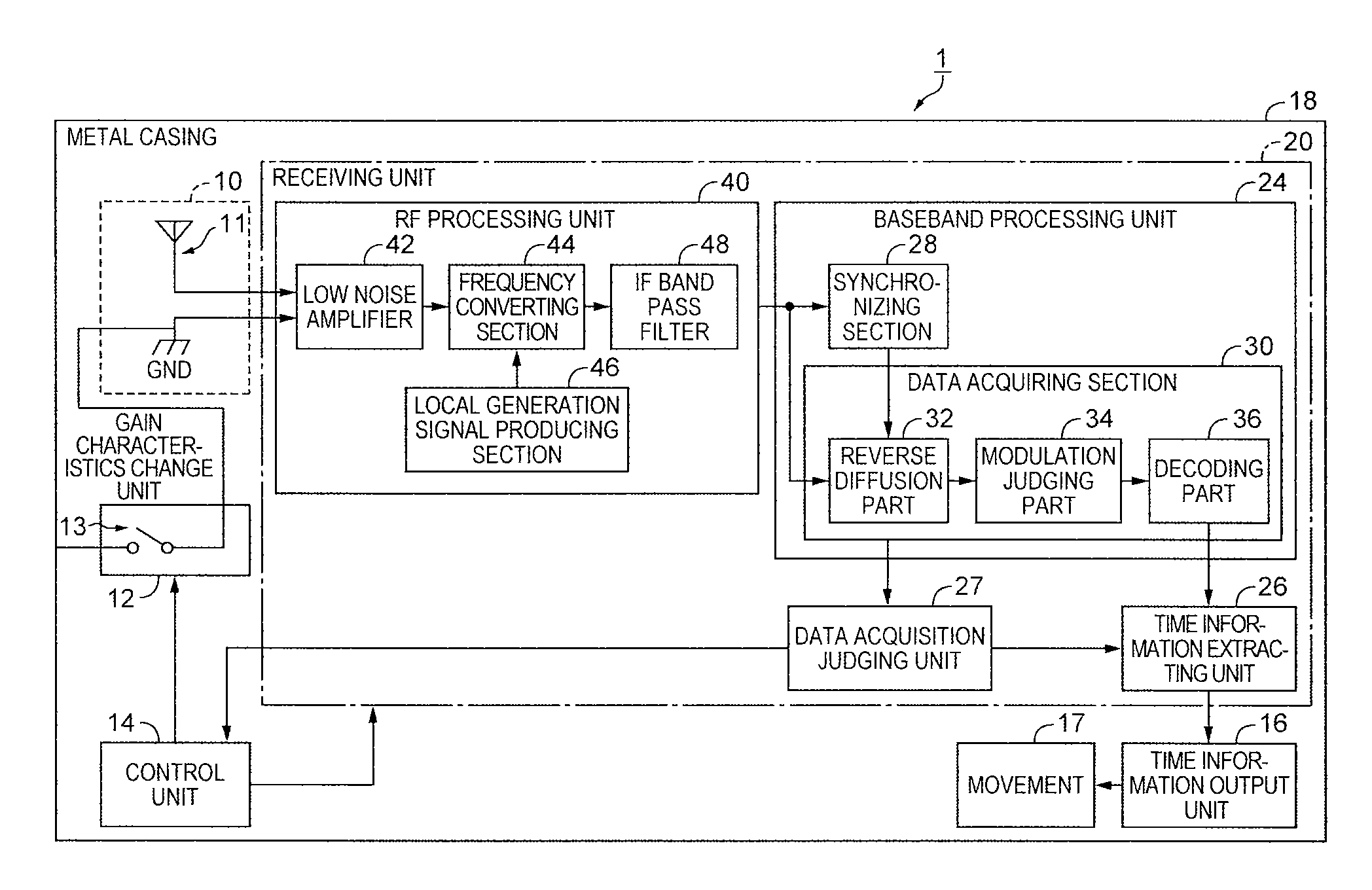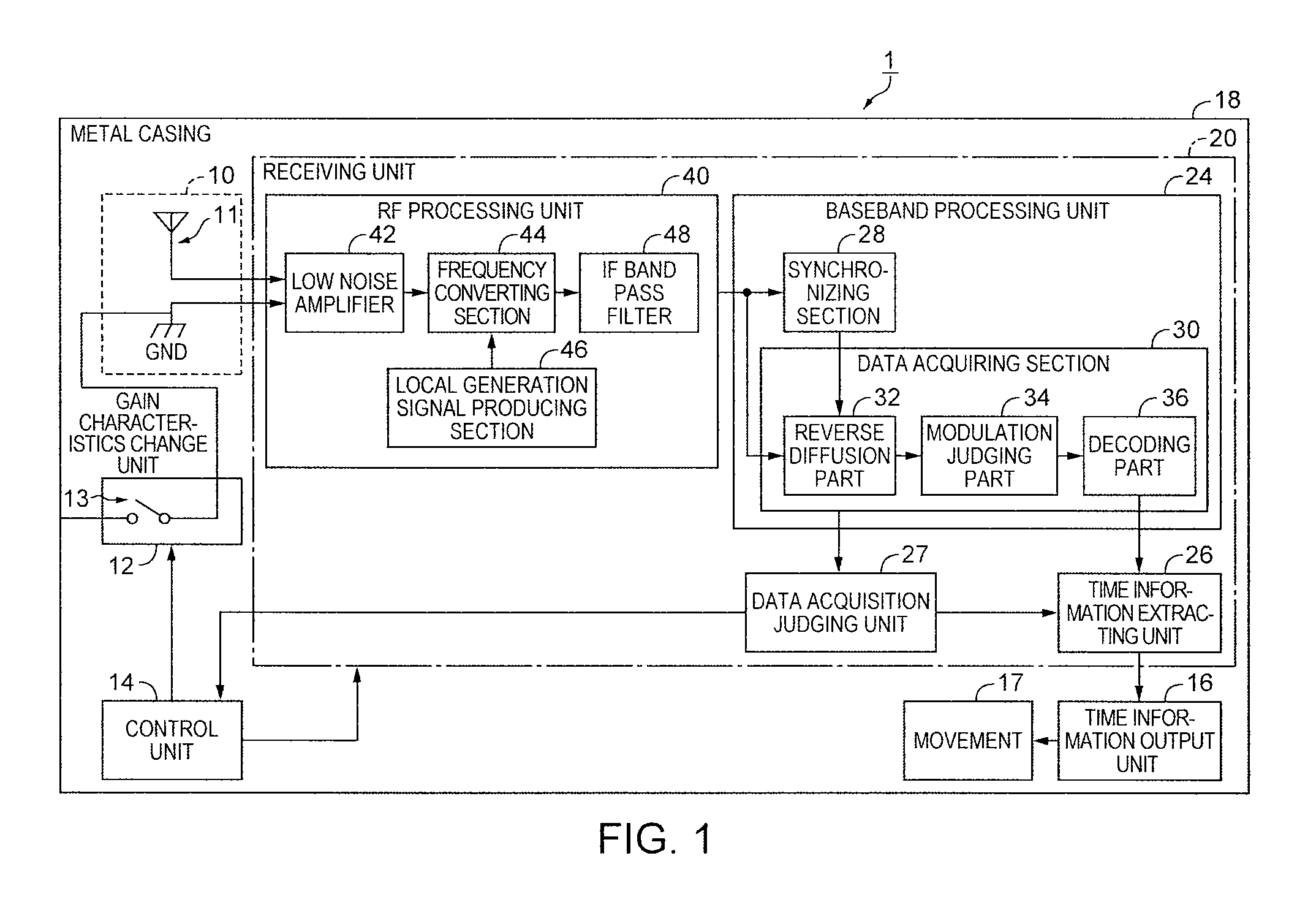Receiving device, radio clock, and receiving method
a technology of receiving device and radio clock, which is applied in the direction of electric winding, instruments, and horology, can solve the problems of reducing the impedance matching and noise mixing, affecting the reception capability, and affecting the reception signal, so as to improve the receiving capability, prevent the noise from mixing, and reduce the impedance matching
- Summary
- Abstract
- Description
- Claims
- Application Information
AI Technical Summary
Benefits of technology
Problems solved by technology
Method used
Image
Examples
first embodiment
[0032]FIG. 1 is a block diagram showing a structure of a radio clock 1 according to a first embodiment. FIG. 2 is a plan view illustrating a part of the interior of the radio clock 1. The radio clock 1 includes a receiving device which obtains standard time information contained in radio waves in an extremely short wave band transmitted after CDMA modulation, and displays accurate time corrected based on the standard time. More specifically, the radio clock 1 includes an antenna unit 10, a gain characteristics change unit 12, a control unit 14, a receiving unit 20, a time information output unit 16, a movement 17, and a metal casing 18. In these components, the antenna unit 10, the gain characteristics change unit 12, the control unit 14, the receiving unit 20, and the time information output unit 16 constitute the receiving device. According to the first embodiment, the radio clock 1 is a wristwatch shown in FIG. 2, and the metal casing 18 is an external metal case of the wristwatc...
second embodiment
[0052]A second embodiment is now described with reference to FIG. 5. In the following description, similar reference numbers are given to parts similar to those discussed above, and the same explanation is not repeated. According to the first embodiment, the control unit 14 controls interruption of continuity between the ground GND of the antenna unit 10 and the metal casing 18 when time information cannot be extracted from a communication signal. In the second embodiment, an electric field intensity measuring unit 50 for measuring electric field intensity is disposed behind the RF processing unit 40 as shown in the block diagram in FIG. 5. The electric field intensity measuring unit 50 measures electric field intensity in response to a command from the control unit 14, and the information about the measured electric field intensity is transmitted to the control unit 14. When time information cannot be extracted from the communication signal inputted to the antenna 11, the control u...
third embodiment
[0055]A third embodiment is now described with reference to FIG. 6. FIG. 6 is a block diagram showing a structure of the radio clock 1 in the third embodiment. According to the structures in the first and second embodiments, the gain characteristics change unit 12 interrupts continuity between the ground GND of the antenna unit 10 and the metal casing 18 via the switch 13 as a mechanical contact to change gain characteristics. In the third embodiment, however, the continuity is interrupted by an electrical switch. More specifically, the gain characteristics change unit 12 has a diode 121, a capacitor 122, and a resistance 123, and controls continuity between the ground GND of the antenna unit 10 and the metal casing 18 by using direct current control voltage and the diode 121. The continuity may be interrupted by a relay in place of the diode 121.
[0056]According to the third embodiment, the following advantage is offered as well as the advantages (1), (2) and (3) provided in the fir...
PUM
 Login to view more
Login to view more Abstract
Description
Claims
Application Information
 Login to view more
Login to view more - R&D Engineer
- R&D Manager
- IP Professional
- Industry Leading Data Capabilities
- Powerful AI technology
- Patent DNA Extraction
Browse by: Latest US Patents, China's latest patents, Technical Efficacy Thesaurus, Application Domain, Technology Topic.
© 2024 PatSnap. All rights reserved.Legal|Privacy policy|Modern Slavery Act Transparency Statement|Sitemap



